Tanks of the Paulista War

 About 100 armored vehicles, 1932
About 100 armored vehicles, 1932
Context of the Revolution (July-November 1932)
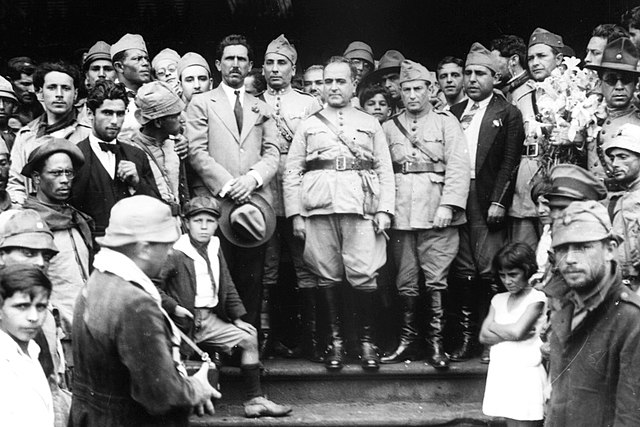
Getúlio Vargas and entourage passing through Itararé on their way to Rio de Janeiro during the 1930 Revolution.
The "Constitutionalist Revolution" was a Brazilian civil war not unlike the Spanish civil war of 1936-39, as much as hard-fought and using "modern" technology (ships, aviation, machine-guns, armoured trains and tanks) but concentrated in just five months.
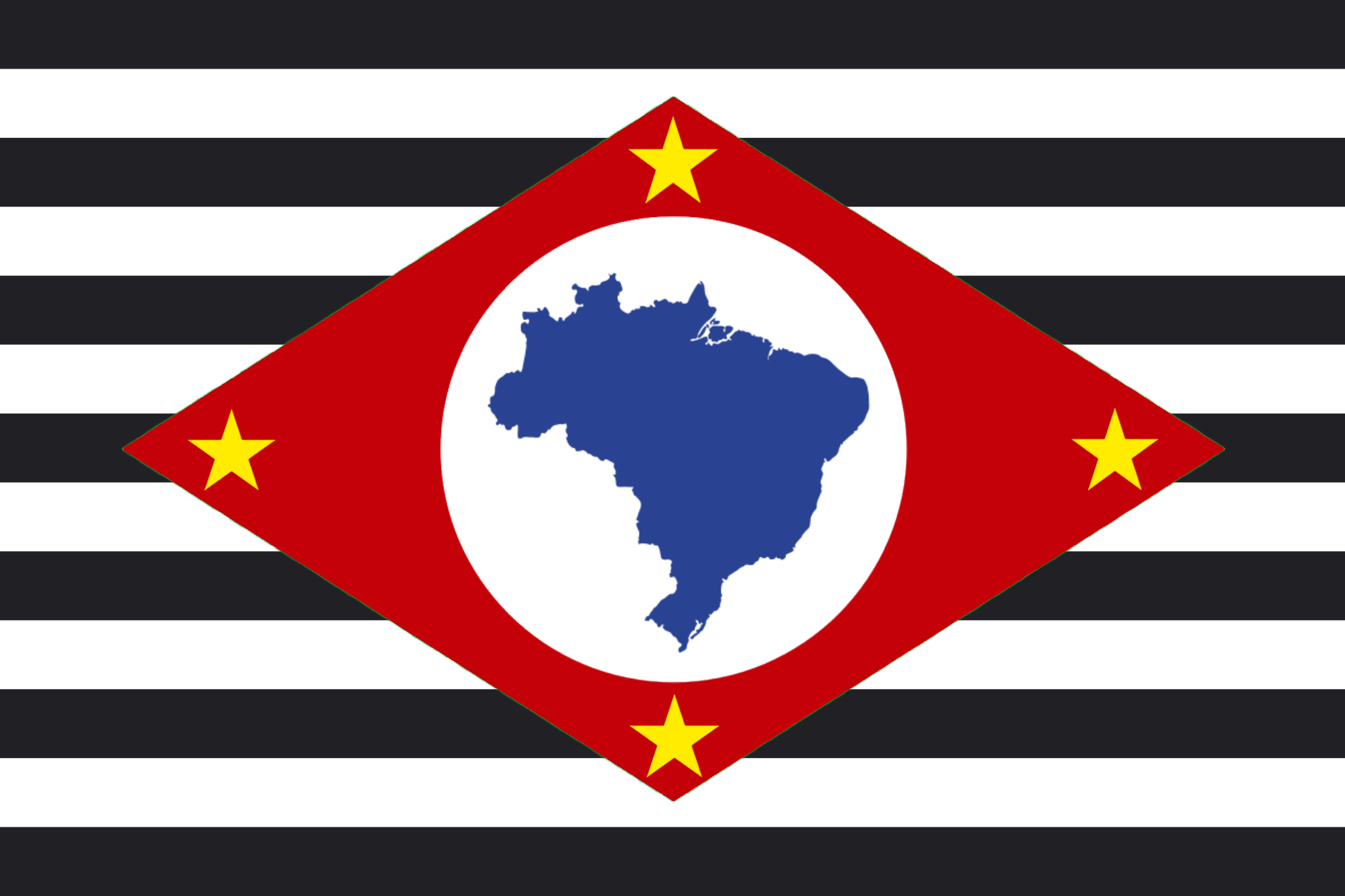
Paulista Flag
The "Constitutionalist Revolution" was an elite and popular uprising in the São Paulo state. It was a reject of the Brazilian Revolution of 1930 that ported Getúlio Vargas to power as president. The latter was supported at the time in all states, both by popular support as well as the military and political elites, in Minas Gerais, Rio Grande do Sul and Paraíba states, by the time the most populated, developed and richest of the Brazilian federation.
However in 1931, resentment grew from autocratic tendencies displayed by president Vargas, which to provide reforms, ruled by decree (over the head of the parliament) in total contradiction to the Constitution, and doing this while in a provisional government, without proper elected support. Thus, discontent affected São Paulo state, as Vargas tried to erode its autonomy, unlike what was granted the 1891 Constitution. Her also prevented election of governor Júlio Prestes which had popular support. It seems the end of the First Brazilian Republic was near.
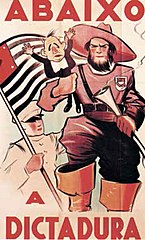 Revolutionaries from Sao Paulo state wanted to constrain the provisional government to adopt a new Constitution, to guarantee it's right, and confirm the election of Júlio Prestes, not only at the state but also after him at the office. Vargas refusal, saw the local press pushing for indurrection, and only rallying more support against the government. Some organization around a movement able to overthrwo the Federal Government or even complete secession and independence of São Paulo (saw separation from the Brazilian federation) for a part of the movement, soon called the "Paulistas" after the state. But for the fedelarists they were simply known as "separatists" or "rebels".
Revolutionaries from Sao Paulo state wanted to constrain the provisional government to adopt a new Constitution, to guarantee it's right, and confirm the election of Júlio Prestes, not only at the state but also after him at the office. Vargas refusal, saw the local press pushing for indurrection, and only rallying more support against the government. Some organization around a movement able to overthrwo the Federal Government or even complete secession and independence of São Paulo (saw separation from the Brazilian federation) for a part of the movement, soon called the "Paulistas" after the state. But for the fedelarists they were simply known as "separatists" or "rebels".
Vargas represented the federation, and all other states, and had the full and loyal support from the army, naval and air force. Paulistas discussed about the use of either a conventional armed push to the capital, or develop guerrilla tactics to gradually weakens the Federal Government. The Federalists on their size, started to mobilize the press against what they called a separatist movement and turn elites and the population in all states against São Paulo. Paulistas commanders still tried to tone down or silence these separatist claims to bring broader support.
Overview of the Operations
The war only lasted a couple of months, really starting on July 9, 1932 after May, 23 saw four protesting students killed by government troops. The revenge MMDC (after the students killed) movement was created and grew large in June and organiazed itself in July into a mostly voluntary military force. There was a state broadcast announcement underlying the open rebellion that this July 9, and the movement tried to also raise political elite's support, in order to purchase weapons and ensure the movement a steady military supply. This did not targeted only Sao Paulo but also elites of Minas Gerais and Rio Grande do Sul. Politicians from São Paulo pushed for a lighting war, knowing on the long run, the largely superior federalists would win.Paulistas Forces
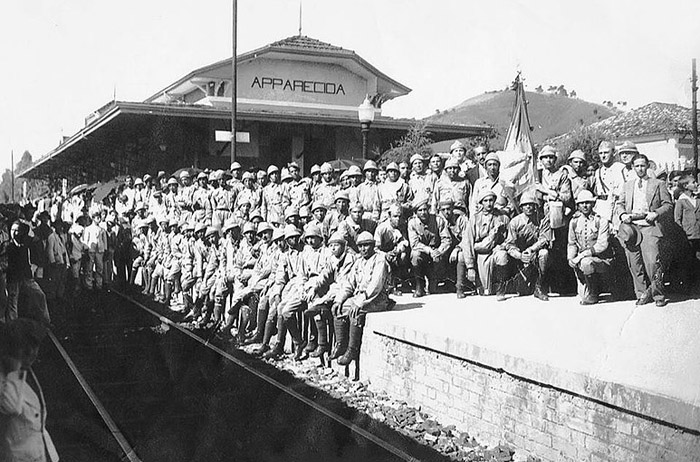
São Paulo's volunteers of the Aparecida-SP railway station prepared to go to the front.
The Federal Brazilian Army had eight infantry divisions, fully equipped (organic artillery and trucks for supply) but facing them, the "Paulistas" only counted on the single 2nd Division, based in São Paulo, half of a Mixed Brigade in Mato Grosso plus the small, but trained and equipped Força Pública Paulista (state military police). However the movement thought of mass volunteering, based on the MMDC militias. By July some 11,000–15,000 men total were under arms, but thousands of volunteers as expected came to grow these figures and in total until the end of the war, some 40 volunteers battalions could be created. It is not certain how strenght they counted, but the figure of 300 men is often accepted. However officers were in short supply and they all needed Training and command. Thus, part of the officers, and a round of quick promotion both in the 2nd division and FPP allocated the necessary officers. In addition, these forces were later bolstered by Maracaju volunteers, and from the Rio Grande do Sul Gaúcho United Front.
As for weapons supplies, the São Paulo state armory had at the time some 15,000 to 29,000 (sources diverged) of rifles and 6 million cartridges (500 millions were needed for 3 months of operations), but not that much ammunition and even less military gear, like pouches and belts. Due to this factor, the Paulistas never could take advantage of all their volunteered and at best had 35,000 men under arms at all times. Foreign armament purchases needed intermediaries and proved complex, most usual suppliers denied their accession to these stocks, still favoriszing the official government. Smuggling started, and there were concerns about setting up arms and ammunition production in the state, but the war ended too seeon for it to be realized. Constitutionalists at best during the fight launched 40,000 men in operations, and they were obliged to ration ammunition in such a drastic way no combatant had more than a 2-3 cartridges to fire a day at best. They were encouraged to raid enemy depots, as per the guerilla war tactics, or intercept trains.
The Sao Paulo state railway support was important, as well as hundreds of trucks but the Paulistas mostly lacked air support (with just a few aircraft for reconnaissance) and lacked any armoured vehicles. For what we are concern, the state was however well developed and there was enough indstry capability to at least create improvized armoured vehicles based on existing tractors and trucks in local workshops It estimated that the Paulistas had approximatively 30 Armored Vehicles in addition to 44 artillery pieces, and a few armored trains.
Loyalist Federal Forces
Brazil fielded seven infantry divisions, 100,000 wel trained professionals, with a third of this number deployed to secure the rearguard, for security purpose and escort convoys. Still, this made for a 2 to 1 advantage, with the added benefit of a strong defence if this path was chosen. But the army under command of Góis Monteiro decided to mobilize and then port the best equipped units in likely paths for the Paulistas to reach the capital, which was based on the terrain. He could count on a massive artillery in organic support (some 250 pieces, mostly howitzers), some 90 Armored Vehicles, including the Renault FTs, the remainder being converted vehicles also in workshops. as well as a comfortable air support of the air force, some 58 aircraft of all types (For reconnaissance, Waco C-18, 20, 21 C-19 and C-4 Fighter-Bombers, Waco M Bombers, Potez A-216 and A-217 or Amiot K-621 Bombers and NiD.72 K-422 Fighters as well).The Brazilian navy also played a role due to the coastal area concerned by the operation, along Sao Paulo state. It was soon decided to blockade Santos, and for this were deployed the 1st Naval Division (Cruiser Rio Grande do Sul escorted by the Destroyers Mato Grosso, Pará and Sergipe). In the air, it was assisted by the bulk of the naval air force, based in Vila Vela, São Sebastiao Island: Three Savoia SM-55s and two Martin PM-1B as well as from the 1st Observation Division at Galeao Naval Base, Rio de Janeiro, four Vought O2U Corsair src. The blockade was of course to prevent any supplies to reach the Port of Santos from abroad. It was efficient.
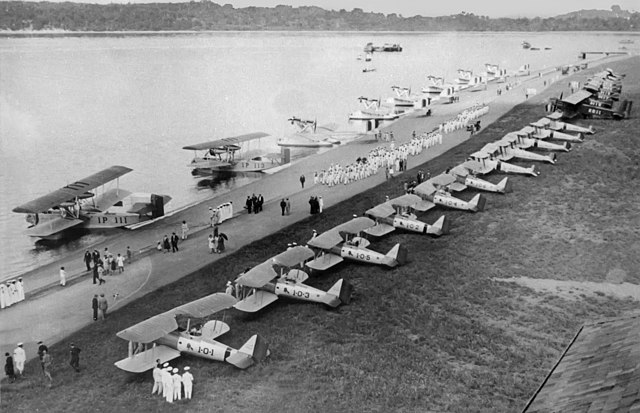
The 11 S-55A of the 1st Naval Sqn. of the Brazilian Navy At some point on 24 September, the Paulistas tried to force the blockade out, attacking with a Laté 26 (cancelled flight due to engine failure), two Falcon and a Waco C-3 the cruiser Rio Grande do Sul, flagship of the 1st Naval Division blockading Santos. Her AA claimed one Falcon and damaged another, but all bombs missed their target.
The Operations:
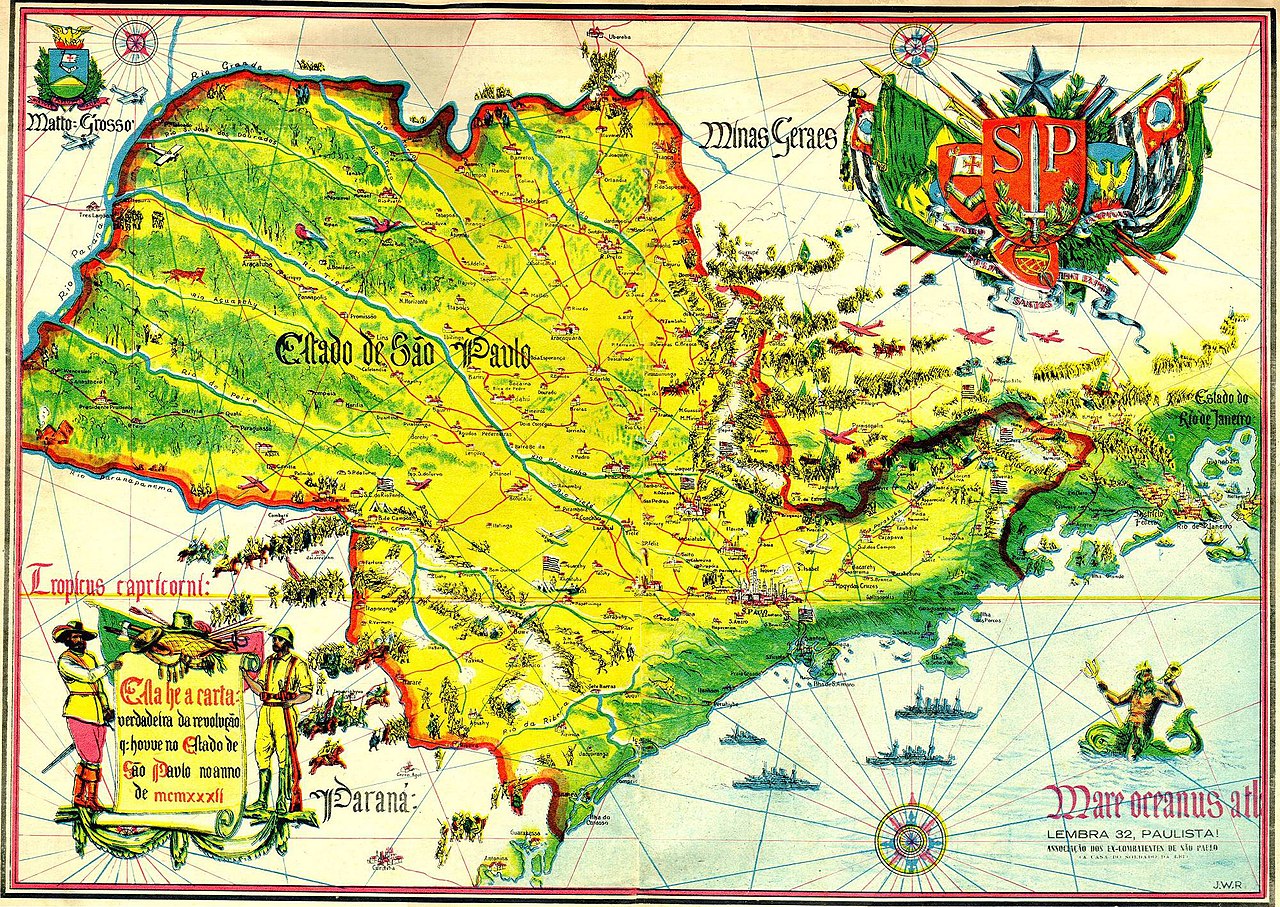
The Paulistas were divided upon their conduct of the war. Some knowing their disadvantages wanted to wage a guerilla war. The leaders among which Pedro de Toledo or Isidoro Dias Lopes or Bertoldo Klinger, were more divided about the issue, seeing the only honorable way to engage and defeat in pitch battle the divisions one by one, playing on speed and surprise, the Napoleonic way. This was also to give them more legitimacy on the international stage. A decisive, mediatized battle against the bulk of the Federal Forces seemed the better way to gain recoignition.
Northern Sector
The Paraíba Valley, called by the troops from São Paulo as the "northern sector", was the main access to Rio de Janeir, seen by them as main theater of the conflict. The Paulistas planned to march on, and seize the city of Resende in Rio de Janeiro, believing this would provoke the adhesion of troops from Minas Gerais and Military Police of the State. This would have been followed by a quick march towards the city of Rio de Janeiro, the Federal capital, to force the effective overthrow of Getúlio Vargas. Troops from São Paulo however moved slower than expected due to a number of factors, notably anticipating the adhesion of other states, which never came. Minas Gerais troops eventually joined federal forces instead and soon went on the offensive against the Paulistas, forced to defend their own territory and put on defense instead. Soon trenches were dug on the borders of the states of Minas Gerais and Rio de Janeiro, resulting in something similar to the Great War in France.The advance of São Paulo troops through the Paraíba Valley took place just after the uprising, to guarantee control of the state. Colonel Odilon Aquino de Oliveira commanded the 1st Company of the 5th Battalion of the state Public Force of São Paulo, and decribed the action in these terms:
"Arriving at Cachoeira with 400 men, I received orders to stop and take up a position, within a defensive plan that ran from the foothills of Mantiqueira, in Cachoeira, through Cunha, to the coast, leaving Tunel and a good part of São Paulo at the mercy of the dictatorial. Authorized to establish outposts in Jataí, four kilometers ahead, I went almost one hundred kilometers further. With my troop I occupied Areias and São José dos Barreiros and crossed the limits of the State of Rio at some points. In São José dos Barreiros, in front of the "Clube dos 200", the 3rd Company of my battalion, under the command of the brave captain Francisco Freitas Borges, had its first contact with the dictatorial troops, represented by scouts from the 1st R.C.D., the first shot of the memorable epic was fired there, on the 12th of July."
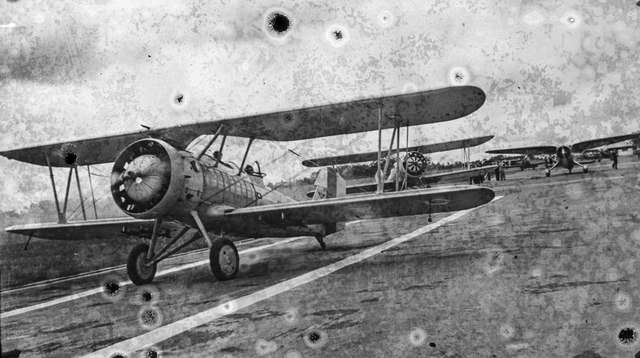
Meanwhile, In the Serra da Mantiqueira region on July 10, Paulistas troops of the 2nd Battalion, 5th Infantry Regiment under Major Henrique Quintiliano de Castro e Silva, invaded the city of Passa Quatro. The city fell five days later however to Army troops led by the 4th R.C.D. of Três Corações (Colonel Eurico Gaspar Dutra). The Palistas eventually withdrew and settled a defensive line on the crests of the Serra da Mantiqueira on the border between the states of Minas Gerais and São Paulo (Garganta do Embaú), above the Mantiqueira Tunnel, off the railway line to Minas Gerais. There, the most violent, intense combats of the war took place, with the highest casualties rate of any front, pointing the of great tactical importance for both forces of this position on the border. São Paulo troops however occupied Piquete, Queluz, Itatiaia, Santana dos Tocos, São José do Barreiro and Cunha on the border.
The Paulistas 2nd Infantry Division held the line in the Paraíba Valley under command of Colonel Euclides de Oliveira Figueiredo, with several detachments manning the trenches. The Cunha region detachment was commanded by Army Lt. Col. Mário da Veiga Abreu, and for São José do Barreiro, Areias and Silveiras, Colonel José Joaquim de Andrade. Queluz region was under command of Army Major Agnelo de Souza. The "flying detachment" used for liaison between Queluz and Areias by Army Major Mariano Gomes da Silva Chaves. Cruzeiro and Túnel da Mantiqueira were under command of Colonel Antônio Paiva de Sampaio, those of Batedor and Entre Rios by colonel Otávio Azeredo of the Public Force (Military Police) of São Paulo. The Piquete region was under command of Colonel Abílio Pereira de Rezende and in August, Major Leôncio de Figueiredo Neiva.
Eventually the city of Queluz fell between the numbers deployed by the Federalists and intense artillery bombardment, and these forces were withdrawn to Vila Queimada, 10 km away. A new detachment was created to defend the left flank based in Pinheiros under Lt. Col. Tito Coelho Lamego. In August new contingents commanded by Antônio Pietscher, José Camilo Valença and Reinaldo Saldanha da Gama reinforced Lavrinhas' position. The federal government under General Pedro Aurélio de Góis Monteiro organized a general counter-offensive on all fronts directed towards São Paulo and Mato Grosso. On map, he wanted a "pincer" strategy including military maneuver and access to resources which the rebels depended.
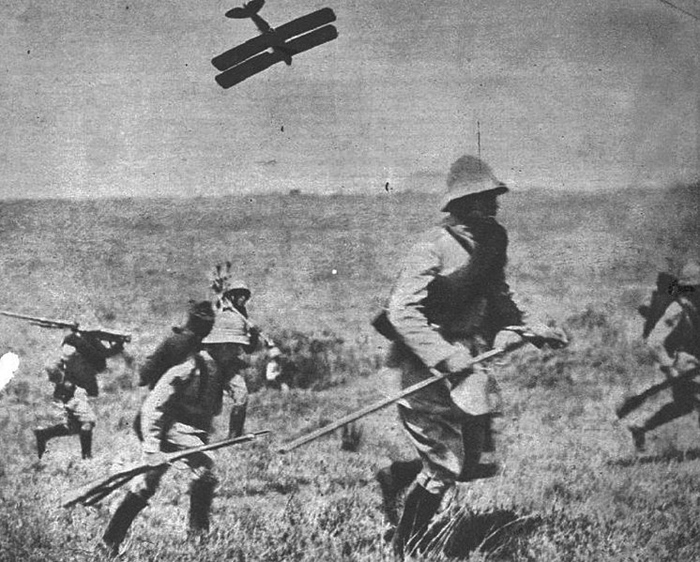
Detachments were organized from several regiments to cover all main access points to both states. The Paraíba Valley is mountainous and rugged and initially favored the Paulistas defence, but the ultimate military superiority of the federal forces prevailed. Colonel Euclydes Figueiredo for the whole line could only muster 10,000 combatants with scarce artillery, machine guns or even bullets. In fact rifles went to miss as well. He still managed sound defensive tactics to partially compensate, using the terrain at its advantage and replacing artillery by the large amount of hand grenades and mortars produced in the state. Opposite them, the federal forces mustered 70,000 combatants, taking turns and relieved, going into permisson, unlike the Paulistas. They were abundantly supplied in all, had more artillery and machine guns or just automatic weapons of WWI and the interwar aplenty, not counting generous ammunition stocks.
Given their positions, the Paulistas (or "constitutionalist" as they called themselves) could not interrupt this supply to the Federalists and were too short in men to mount guerilla raids beyond the lines. They had to make due in defense with one automatic weapons for 50 men, (versus one for 3 men among the Federalists). It was a cruel reality that makes all assaults by the latter, un unstoppable push when correctly executed. Thus, the Paulistas had withdraw continuously and tried to stop persistent infiltrations in the widely streched line. In the end, they could ne prevent several cities in São Paulo State, along the Paraíba Valley, to fall, such as Queluz, São José do Barreiro, Areias, Silveiras, Cachoeira Paulista, Cruzeiro, Piquete and Lorena. There were still localized tactical victories like the battle of Cunha in August 20.
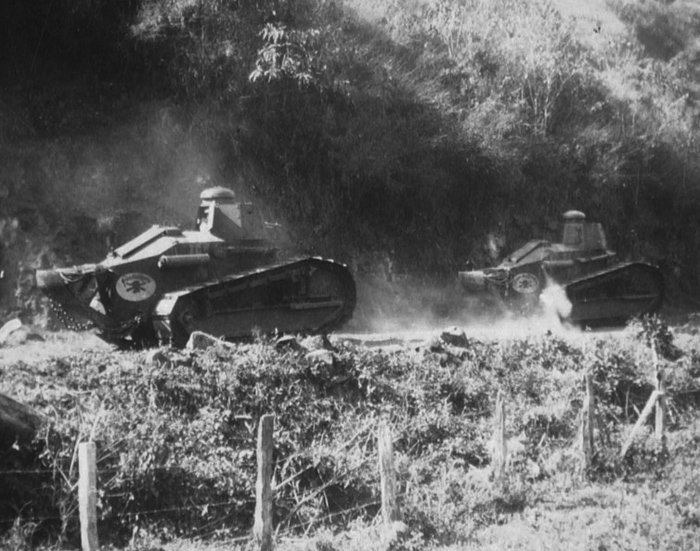
The use of artillery was intense and a bombardment always preceded an infantry attack like in WWI, in order to weaken the opponent's position, and it was not rare that cavalry troops were sent in through the gaps. The federal troops's superiority greatly favored their gradual advance. The paulista's artillery could only neutralize or delay offensive. On July 17, 1932, Battery Captain Arcy da Rocha Nóbrega, positioned in the Garganta do Embaú was responsible for the first shot of the Paulistats against federal troops and from its position, could bombard the Manacá railway station 5 km south of Passa Quatro. He became proficient in counter-barrage fire and harassment on demand, even even succeeded in destroying the opposing battery.
The Paulistas commander of the northern sector and Constitutionalist Army were respectively Colonel Euclides Figueiredo and General Bertoldo Klinger. They were strongly influenced by German military doctrine and emphasised on a defense in depth. This was also applied on the southern sector's Captain Joaquim J. A. Bastos which created an ompresive maze or parallel and criss-cross lines dotted by outposts and better garrisoned trenches in the rear. This spent the Federalist's superior artillery in vain on mostly empty trenches, whereas when the infantry advance was signalled, the rear troops went forward and manned these shelled trenches, ready to repel the wave. This spared resources and greatly minimized casualties. The Paulistas were ever ready to retreat to another prepared position to the rear, and this enabled an attrition war of the federal troops much like the Germans held the lines against repeated French, British and later US attacks at a very unfavourable ratio.
Between September 12 and 13, 1932, the Paulistas however withdrew their main line to Engenheiro Neiva (Guaratinguetá) to resist a general offensive of Lorena divisions. The retreat was covered with success by the combination of the Armored Train nº6 and the armored vehicle FS-8. From the new positions thes Paulistas awaited the final assault. One of this sector was called the "Última Trencheira", immortalized into a famous poem and song by Guilherme de Almeida ("Prayer before the last trench"). The city of Guaratinguetá during this last assault of the war heavily targeted by artillery and federalists bombers as well, almost a "Guernica" before the real one.
The Eastern Front
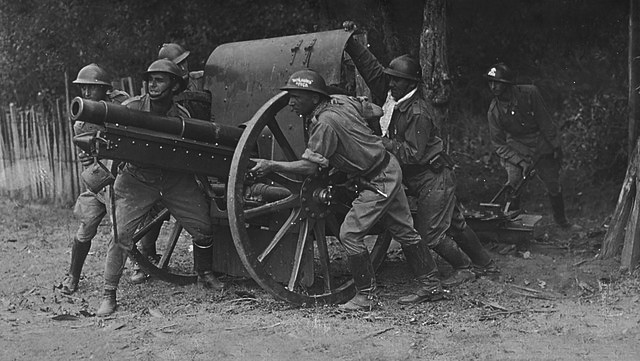
This more fluid front comprised the border with Minas Gerais, northeast, north and northwest of São Paulo. It was defended by mixed troops of volunteers and members of the Military Police, with few Army detachments. The organization was considered one of the most unstable, and saw multiple changes in command and organization. In the first weeks they were ordered by Colonel Francisco Júlio César de Alfieri to imply hold the line against a possible invasion of the area, but João Dias de Campos resigned after the fall of the Itapira subsector, replaced by Colonel Oscar Saturnino de Paiva, then Eduardo Lejeune and Herculano de Carvalho e Silva until the surrender. This sector comprised the Mogi Mirim region (between Socorro and Mococa) Franca, Rio Grande, Ribeirão Preto and Barretos, Presidente Venceslau, Presidente Epitácio, Bauru region, São José do Rio Preto, and Bragança Paulista.
The first battalions from São Paulo seeing their baptism by fire were the "Fernão Dias Battalion" and "Paes Leme Battalion" formed by volunteer civilians. By July 15 they received orders to take the cities of Jacutinga, Ouro Fino and Pouso Alegre. Federal troops anticipating this had cut railroad lines, destroyed the bridges, to delay their advance. On July 20 in the afternoon near Borda da Mata they were counter-attacked and improvised their defense, holding it until the 21st. Short of troops and ammunition, they retreated to Eleutério, leaving on the field many troops and the commander Fernão Salles.
Further north and northwest battles saw the mixed detachment of Colonel Manuel Rabelo and Battalion "General Marcondes Salgado" (Antenor Gonçalves Musa) left for the northern front between the Rio Grande and Paraná River. The Federalists invaded the state of São Paulo, and devised a plan to gradually surround São Paulo troops from the Minas Gerais front, creating a pocket between Mogi Mirim and São João da Boa Vista. Until August 1932, the Salgado Battalion saw fierce combat in the north of São Paulo, banks of the Paraná and Rio Grande, with the battles of Barra Grande, Maricota, Antonio Prado, Cemitério, Antunes, Horácio, Central, Guaracy, Porto Sapé and Porto Isaac. The paulistas were still reinforced by a few hundred local volunteers creating a large column under lt. Major Quintino de Freitas, sent to retake Porto Taboado occupier by troops from Goiás and Minas Gerais and strategic point on the Paraná River.
On August 11, the São Paulo column reached to Porto Taboado aided by a small local contingent (Colonel Eduardo Lejeune) but saw a major attrition battle at Lussanvira-Porto Taboado road close to the Paraná River. By August 17, after intense fighting the Paulistas eventually occupied Porto Taboado. They were further reinforced by a Bauru compay (Captain Antônio Ferreira da Silva, part of the 4th Volunteer Battalion's chasseurs)Hpart of General Ataliba Leonel's Southern Brigade, and then by troops from Lussanvira and Pereira Barreto (Major Santini) which helped rounding up federal troops. This was one of the other tactical successes of the Paulistas.
The famous "Coluna Romão Gomes" operated with some 1,500 combatants was accredited to never lost a battle during its entire campaign. However this "flying colum" successes could not prevent the bad defense led by Col. Dias de Campos and Saturnino de Paiva. They never created a retreat defense line nor fortifications further to the rear. Saturnino de Paiva only started at the end of September the construction of fortifications in the Serra dos Cristais (Jundiaí) but it was too late, as negotiations for the armistice already started.
The local Paulista's resistance was improvised according to the way the combat, but with poor anticipation of the next Federalist moves and "no backup". The detachments were also poorly coordinated. In some cases, tactical victories were wasted for such reasons, with some Paulistas detachments gaining positions, while the neighboring detachment retreated in disarray, and seeing the first one, left uninformed, ultimately surrounded and made prisoner. Some commanders also disagreed with given orders, and in the end, the Federalists managed to infiltrate the defenses of São Paulo and having better intel, managed to identify weak points and intensify the offensive until being able to march on the capital.
The Southern Front
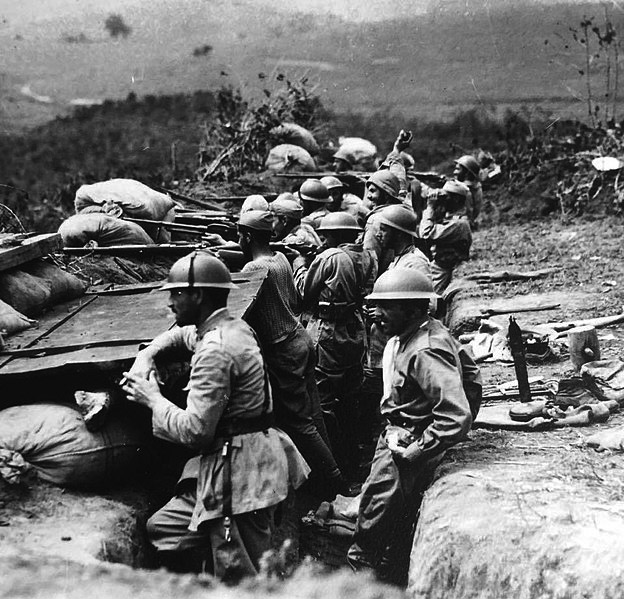
The southern sector comprised the border region with the State of Paraná, defended by mixed troops from São Paulo under general command of the Military Police of the state. They very much followed the organization of the eastern sector's command. The first days of the conflict saw Itararé defended by lieutenant colonel Pedro de Morais Pinto and further south at Capela da Ribeira the 9th Battalion and 2nd Cavalry Squadron under Lieutenant Colonel Azarias Silva. Further north at Ourinhos, Dias de Campos. Itararé was strategic, but the least garrisoned of the Paulistas positions in the belief promise support from Rio Grande do Sul, which soon turned out false.
On July 12, General Guilhermino Ribeiro Cruz ofthe Federalist's 5th Army Division, sent vanguards there, as part of the local advance force on São Paulo. On the 16th, General Valdomiro Castilho de Lima arrived and assumed command and for the next moves, counted on the railway line and roads through Itararé, Capela da Ribeira and Ourinhos as main objectives. The siege was added to a concentration in the Paraíba Valley where resided the main communication lines with Rio de Janeiro. Meanwhile, contingents on the Minas Gerais front and on the São Paulo coast were blockaded by the Brazilian Navy. Any coastal move in range of the cruiser and destroy's guns was easy meat.
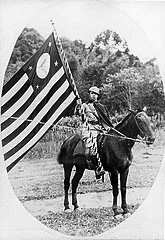 On that front, Paulistas forces had a detachment in Baixo Paranapanema between Presidente Epitácio to Itaporanga (Col. Paulo Pedro Dias de Campos). By late July Major Azevedo's column opened a bridgehead over the Paraná territory to contain the advance of federal troops, taking Cambará, Bandeirantes, Jacarezinho, Santo Antônio da Platina and Ribeirão Branco. South of São Paulo at Capella da Ribeira a small mixed contingent (Lt. Colonel Azarias Silva) defended the sector on July 31 but later retreated to the new defense line in the Alto Paranapanema region. There all forces present were commanded by Colonel Brasílio Taborda with detachments in the Buri region and Campina do Monte Alegre (Christiano Klingelhoefer) Capão Bonito (Major José Anchieta Torres) and a liaison detachment in Campina do Monte Alegre (Lieutenant Colonel Luiz Carneiro de Castro e Silva).
On that front, Paulistas forces had a detachment in Baixo Paranapanema between Presidente Epitácio to Itaporanga (Col. Paulo Pedro Dias de Campos). By late July Major Azevedo's column opened a bridgehead over the Paraná territory to contain the advance of federal troops, taking Cambará, Bandeirantes, Jacarezinho, Santo Antônio da Platina and Ribeirão Branco. South of São Paulo at Capella da Ribeira a small mixed contingent (Lt. Colonel Azarias Silva) defended the sector on July 31 but later retreated to the new defense line in the Alto Paranapanema region. There all forces present were commanded by Colonel Brasílio Taborda with detachments in the Buri region and Campina do Monte Alegre (Christiano Klingelhoefer) Capão Bonito (Major José Anchieta Torres) and a liaison detachment in Campina do Monte Alegre (Lieutenant Colonel Luiz Carneiro de Castro e Silva).
The detachment at Angatuba and Bom Sucesso was commanded by Colonel Milton de Freitas Almeida and in Apiaí and Guapiara, Major Luís Tenório de Brito, then to the Guapiara line, replaced by Pedro de Morais Pinto and linking with the south coast of São Paulo. The São Paulo forces in Alto do Paranapanema had cavalry detachments for mobile action, using containment maneuvers, harassing government troops in their rear lines to reduce pressure on the defensive lines. The largest and most famus was the Cavalry Regiment of Rio Pardo (captain Alfredo Garcia Feijó and Major Sebastião do Amaral).
The main federal forces. The main cavalry force under Nelson Palmeiro Pinto Dias (one squadron and platoons of the 1st Battalion of Paraná) later join Colonel Ayrton Plaisant, which advanced on Apiaí, Guapiara and Xiririca and later Buri and Alto Paranapanema, with new detachments constituted from the reserve troops to occupy the Buri and Capão Bonito regions and Rio das Almas region. Rio Grande do Sul's state intervenor General José Antônio Flores da Cunha assured the Federals that he would not join the constitutionalists but when the insurrection broke out, he remained indecisive. On July 10, he chose the side of the government and publicly declared his support for Vargas. On July 11th, the 1st squadron, 5th Divisional Cavalry Regiment of Castro left by train for Jaguariaíva and sent a reconnaissance squad to Itararé, in São Paulo. Soon the commander of the 8th Batalhão de Caçadores Paulista in Itapetininga sent 200 men to make them retreat to Sengés (Paraná territory).
The 1st and 2nd Battalions of the 13th Infantry Regiment from Ponta Grossa arrived in Jaguariaíva (José Ricardo de Morais da Veiga Abreu) and clashed on July 16-18 around Itararé, against the Federal Forces of the South. A plan was established with repeated the revolutionary campaign of October 1930. But on the the 15th the São Paulo Battalion "14th of July" arrived at the military square of Itararé, joining other units to constitute a large detachment (Lt. Colonel Pedro de Morais Pinto) under overall command of General Valdomiro de Lima. One unit took position towards Passo do Cipriano at the northwest of Itararé. The "14 de Julho" Battalion moved with just 12,000 rounds, leaving the rest in the capital, São Paulo. With 50 rounds per soldier they stayed in reserve at Itararé while its commander Major Mário Rangel realized Itararé's defense lines were took weak, lacking in depht defense and fortifications, alerted the detachment's commander which mobilized its troops to reinforce these.
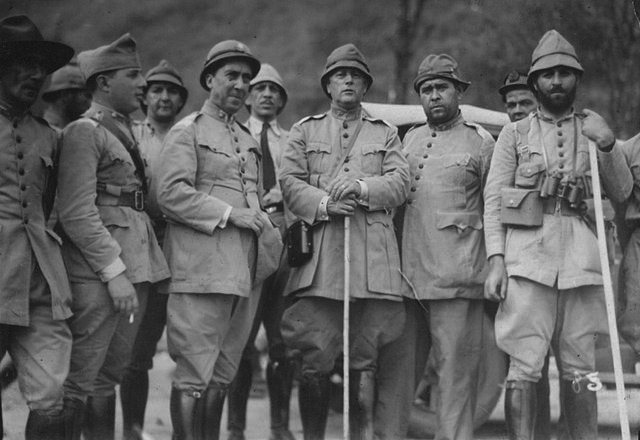
Northern of Itararé at "Passo do Cypriano" were located the weakest troops, with poor supplies or logistical support and by July 16, suddenly attacked by federal troops under Valdomiro Lima, which choose precisely to go through the "Passo do Cypriano" entered São Paulo territory and started to cut the rear of the constitutionalist troops at Ibity, which ended with the fall of Itararé on July 18. The lines collasped mostly due to the promised support from Rio Grande do Sul never realizing, precious time being lost due to indecision until detachments were reorganized into edgehogs in strategic positions around São Paulo. Itararé was soon besieged.
Long story short, and Colonel Brasílio Taborda assuming command of the southern combat sector adopted a defense in deep strategy, German doctrine style as in the north. He wanted to reach the largest attrition in combat to delay the federal advance on the capital, saving resources, ensuring that by fixing the Federalists, he would allow the norther front Paulistas to concentrate and make a drive to Rio. The colonel was relatively successful, as Federalist General Valdomiro Lima from July 22nd to October 2nd at the surrender managed to advance just 20 km beyond Buri. Federal troops were posted along the Paranapanema River, wheras the São Paulo trenches were positioned on the east bank, locking the situation for months on end.
Coastal Operations
When the conflict started, the Paulistats formed a defensive perimeter around the Port of Santos (main port to Sao Paulo), using mines and coastal artillery, leaving garrisons in the Itaipu Fort and other strategic points in order to prevent the approach of the Brazilian Navy squadron, or Brazilian Marines assault under command of Minister of the Navy Protógenes Guimarães. Though the Brazilian squadron surrounded the São Paulo coast without closing on the port, and effectively prevent reinforcement and shipping supplies, a blockade which also impacted the population and nullified São Paulo trade. The mines were underwater moore types designed and produced by engineers and technicians of the Polytechnic School of São Paulo, so they were custom-built.The coastal detachment under Colonel of the Army Cristovão Colombo de Melo Mattos had an impossible taskn defending the entire coastline notably at Serra do Mar, and had small garrisons spread between Santos, Praia Grande, Guarujá, Peruíbe, Cananeia, Ubatuba, Jacupiranga and Xiririca. The Federals attacked there too, leading to battles at Cananeia, Colônia Santa Maria and Xiririca, Guarçouba, but the most important points were still held until the end of the war by the Paulistas. No Marines landing was performed.
Mato Grosso
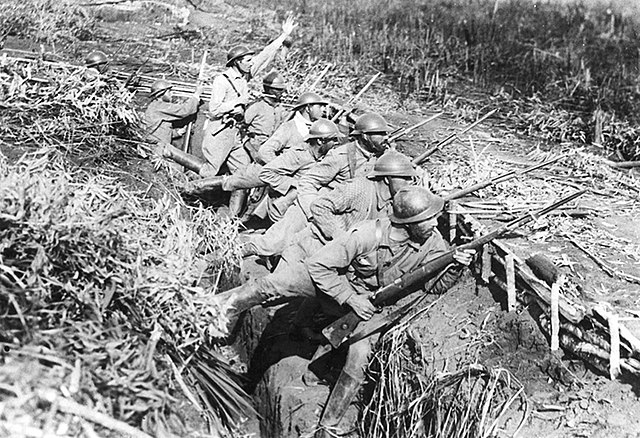
The state of Mato Grosso became São Paulo's only ally during the war, and after the start of the uprising, the southern region (Mato Grosso do Sul) declared its autonomy and support fopr the constitutionalists. This area became the State of Maracaju, capital Campo Grande with Vespasiano Barbosa Martins at its head. By July 1932, General Bertoldo Klinger commanded the forces of Mato Grosso, promising 5,000 soldiers and ammunition for the Paulistas. However after his dismissal, the local uprizing mostly failed. Troops in Cuiabá and in the Corumbá region remained loyal. Colonel Oscar Saturnino de Paiva took command and joined the uprising, later Lt. Colonel Francisco Jaguaribe Gomes de Matos, then Colonel Nicolau Bueno Horta Barbosa. Saturnino de Paiva assumed command of the São Paulo detachment's eastern sector in Campinas.
Detachments from Maracaju took strategic positions to control the region, and attacked federalists troops at Santana do Paranaíba, repelled a column coming from Goiás, as from Três Lagoas and Porto XV de Novembro. In Coxim they quelled a column from Cuiabá and at Bela Vista, the city was seized. To the west, the city of Corumbá, River Base of Ladário, Porto Esperança, Fort Coimbra and, and Porto Murtinho were also seized. On September 12, 1932, was the onlymajor riverine battle of this war, with the flotilla led by the river monitor Pernambuco escorting ships with government detachment (Colonel Leopoldo Nery da Fonseca Junior) being soundly defeated.
The battles for Porto Murtinho and Porto Esperança were firecely contested ones, but also contributed to the Paulista's cause. It ensure the entire control of region now encompassed by the State of Mato Grosso do Sul to the Paulistas and guaranteed access to the Atlantic Ocean via the Paraguay River, Paraná River and Brazilian border with Bolivia and Paraguay to nullify the Brazilian Navy blockade. By mid-September, part of the Mato Grosso force was sent to reinforce the south and east front of São Paulo. Performance of Maracaju state troops was later recognized as overall remarkable by São Paulo commanders.
Rio Grande do Sul
Although General Flores da Cunha (Rio Grande do Sul governor) was an ally of Getúlio Vargas, a group of Gauchos joined the fight with the Paulistas. They were led by Borges de Medeiros and were able to create a battalion of about 450 men. Unable to take on the fight to local Federalists forces, instead they turned to a guerrilla campaign, distracting federal troops and prevent detachments to reinforce the forces already engaged off São Paulo. Again, german influence here, but Borges de Medeiros tried to emulate Paul von Lettow-Vorbeck in Africa, which tried down enormous allied forces (British, French and Belgian) there for the duration of the conflict.The Rio Grande do Sul "front" came to an end at the Battle of Cerro Alegre in Piratini on September 20, 1932. The Federal forces managed to corner Borges's Batallion and through artillery and repeated attacks, managed to kill or wound the entire force, Borges de Medeiros being arrested. Their defeat added to the difficulties at São Paulo since it stopped the arrival of military resources, enabled federalist reinforcement on an already hard-pressed front, and became one of the reasons why the Constitutionalist Army requested an armistice on 28 September.
Defeat of the Constitutionalists Which such discrepancy of forces and none of the expected support materialize, São Paulo's revolt was militarily crushed on October 2, 1932. 87 days of fighting (July 9 to October 4) saw the ultimate surrender of São Paulo. Between perhaps 6,000 death of both sides, and widespread damage across the capital and neighbouring cities the revolutionary were ironically granted by Vargas the appointment of a non-military state Governor, election of a Constituent Assembly and a new Constitution in 1934. By 1937, growing extremism conducted Vargas to close the National Congress, re-established the former Constitution and creating the dictature-like "Estado Novo" after a coup d'état.
Armored Vehicles used in the war
Paulistas Armoured Trains
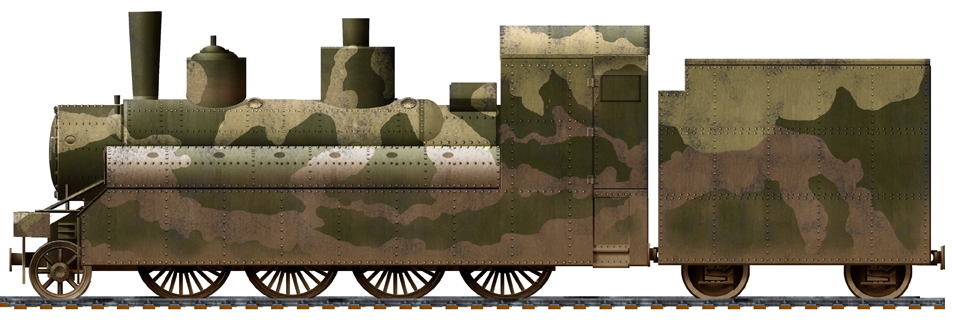
The most famous Paulista armored train, "Fantasma da morte", armoured, camouflaged locomotive and coal wagon.

TB-6 ("Fantasma da morte") main armoured wagons, with a single turret machine guns on the second wagon and Schhneider gun on the first behind a sloped plate armour.
There were two aspects in this war, the use of armoured trains and of regular and improvized armored vehicles. For the armoured trains six (TB-1 to TB-6) constituted by the Paulistas met success. Using regular trains and with some wagons partially or totally protected, as well as locomotives, they pulled or towed full armoured support wagons, some with artillery, some with machine-gun turrets. The best known was "TB-6" later nicknamed "phantom of death" which received direct 37 mm fire and 75 mm shrapnel, or generous rifle and MG fire from federal troops, while playing a fundamental role in covering the troops from São Paulo when they retreated to Guaratinguetá. The nickname "Fantasma da morte" came from its night raids, sneaking up close to enemy positions, turning spotlights on trenches and starting a harrowing fire from rifles and cannon, following by the Paulistas troops rushing from their wagons. This enabled to take Federal positions at several occasions.
Armored Vehicles of the Paulista War
1924 Revolution Vehicles

Brazilian White Laffly ACs in 1921
In 1924 already, the state of Sao Paulo used armored cars during the revolution of 1924: White-Laffly armored cars has been purchased from French stocks indeed, and the 1924 vehicle kept its orignal features. A single, large "armored car" model 1924 was also improvized, as a 4x2 built by revolutionaries in Sao Paulo, but it proved too heavy to be operated off of hard roads. The second vehicle ("Carangola") completed used wood rather than steel for protection...
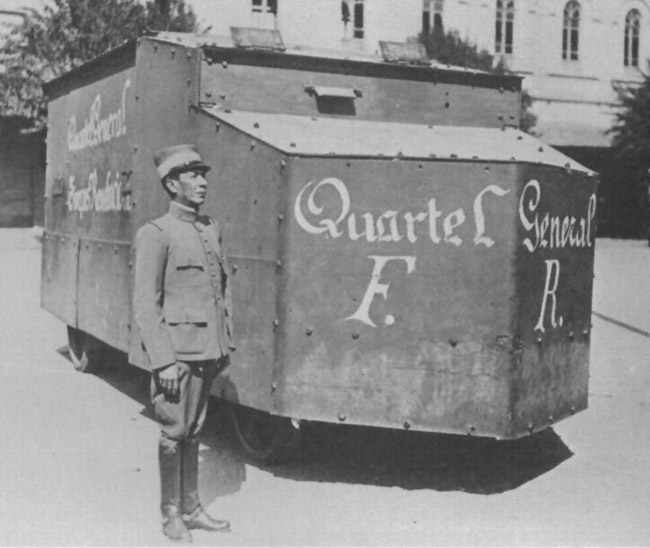
Quartel da Luz armored car in 1925
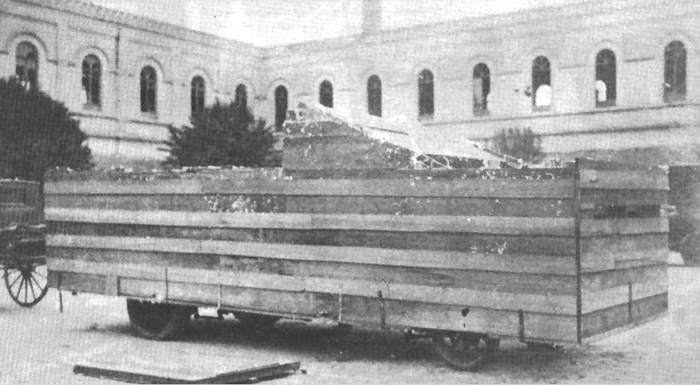
Improvized wooden Armored Car in 1925
1930 Revolution Vehicles
In 1930, same story, one of two improvised armored cars were produced in Minas Gerais, a Chevrolet Improvised AC and the other model had shields over the rear wheels, no turret. Hand held rifles were used from inside. It was powered by a gasoline engine, had manual transmission, reinforced leaf spring Suspension, front axle steerable only. The other vehicle was very similar in shape to improvised armored cars used in the Spanish Civil war, and had a fully rotating turret with light machine gun mounted on top, single vehicle completed to this design.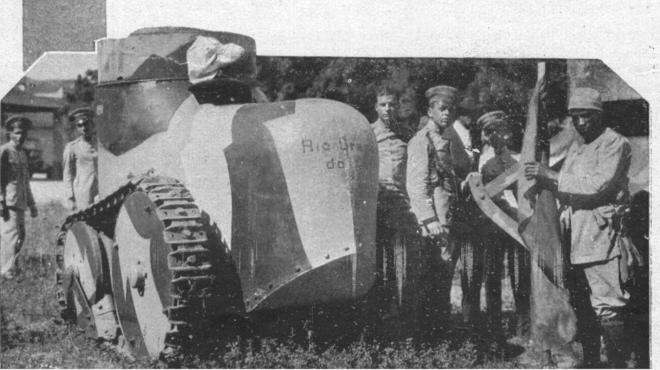
"Rio Grande do Sul" armored tractor from the Estaleiro So.Co in 1930.
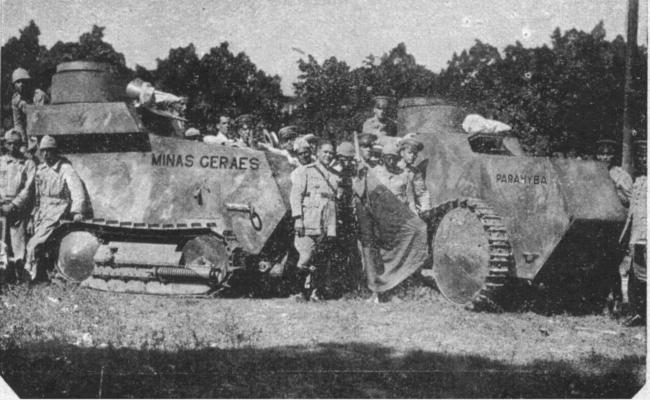
Armored tractors "Minas Gerais" and "Parnaiba", 1930 revolution
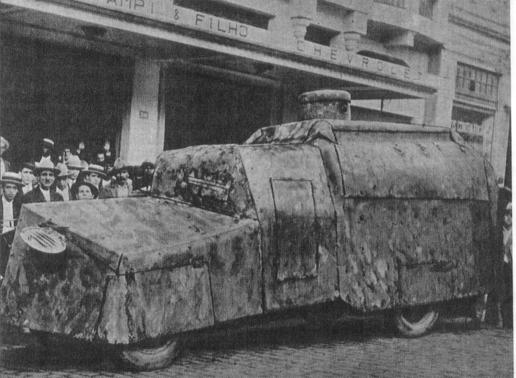
Turreted Chevrolet AC in 1930
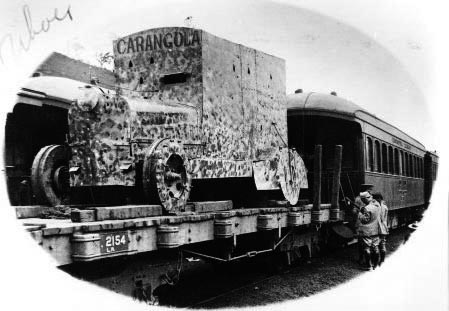
Belo Horizonte AC "Carangola", 1930
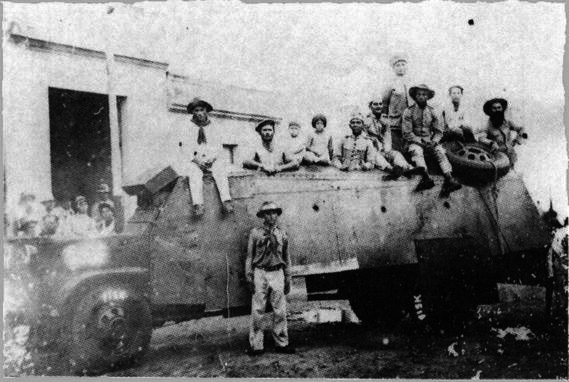
Parnaiba's "Campina Grande" AC
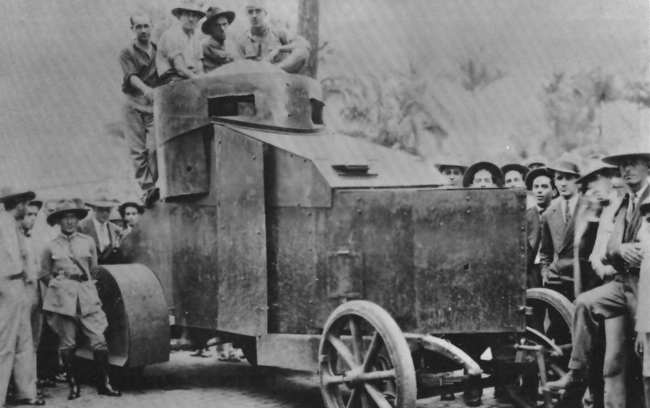
Palmyra AC, 1930 revolution
Tanks and Armored Cars of the Constitutionalists in 1932
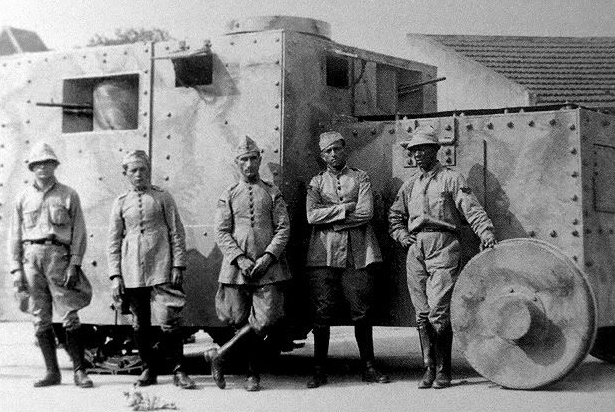
FS-6 in operations
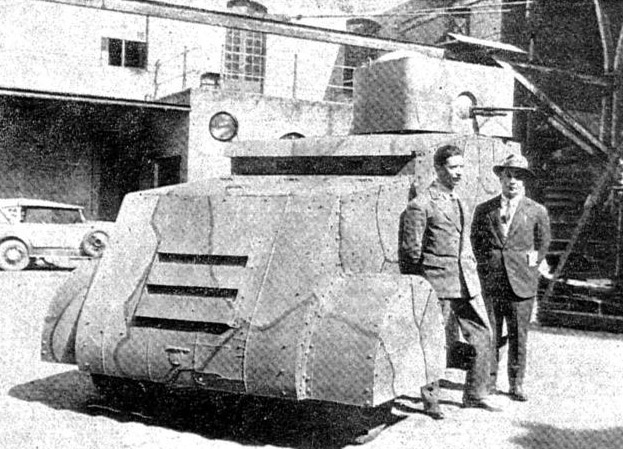
FS-2 built by J.Martin & Co.
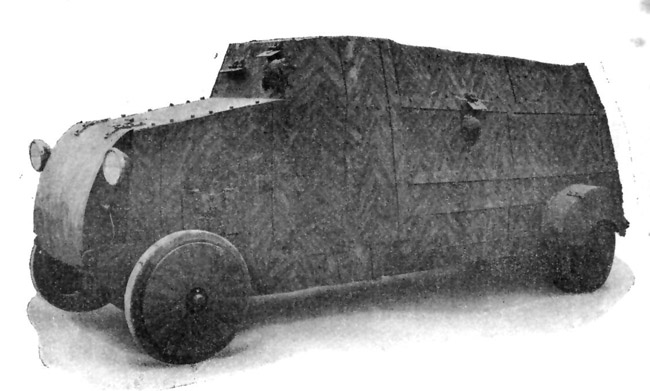
FS-8 APC
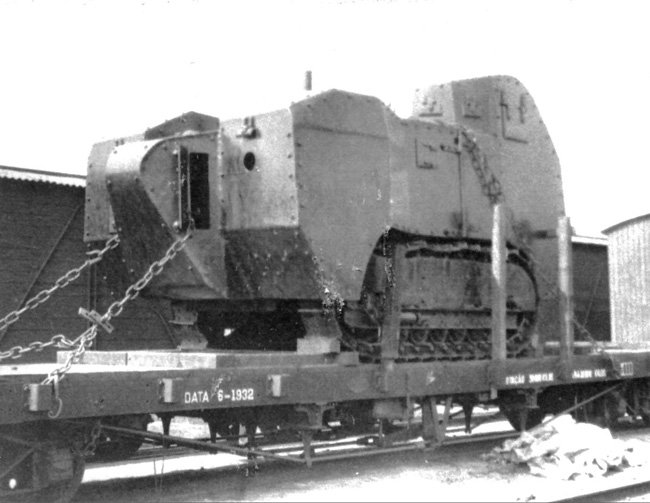
Armoured Tractor transported by train
The Polytechnic School of São Paulo and Technological Research Institute designed and built several types of armored vehicles for the cause: Armored cars, armored tractors, and even armored speedboats to combat the blockade or smuggle ammunitions and supplies via rivers.
The armored assault cars were based Ford, Chevrolet and MacCoorning Deering cars and trucks mostly. Most of them were built in Foundries & General Workshops Viúva Craig and co. as well as J.Martin & vo. of São Paulo, under technical supervision of Engineer Francisco de Sales Vicente de Azevedo and detached engineers from the Polytechnic School. In total, six armored cars were manufactured, receiving the "FS" designation, in reference to their author, Francisco de Sales. These armored vehicles were however derived from thick steel plating and had to make due with thinner plates, still 12 mm thick but interleaved with sheep wool to buffer projectiles. Naturally they all had reinforced suspension with extra leaf springs to cope with the additional weight.
Some had rotating turrets to mount either a light machine gun, Hotchkiss 7 mm most of the time. Throughout the conflict, improvements were made. These armored cars were however spread thing between all fronts, buty they mostly served on the borders, to the states of Rio de Janeiro, Minas Gerais and Paraná. In average they carried a crew of four men including the driver, with the exception of the truck-based FS-8 whoch could carry up to eight soldiers. The latter was operated in the Paraíba Valley with a "jungle type" leaf camouflage. However the norm, if not olive green painted, was to use the WWI French pattern, using brown, green and light blue.
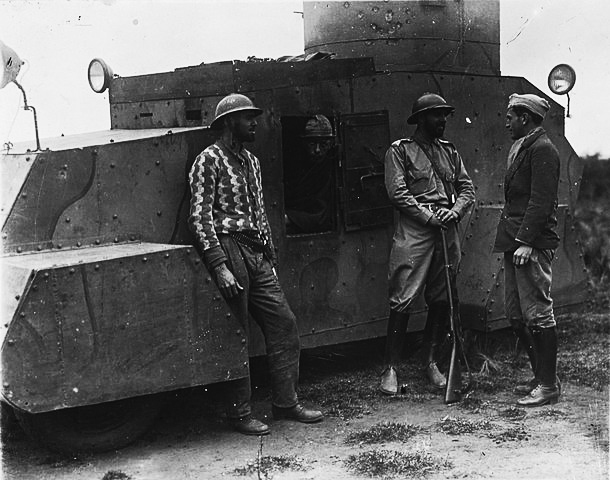
Reporter Armando Brussolo speaks with Captain Affonso Negrão next to the self-armored FS-1 "14 de Julho", in September 1932, in the district of Gramadinho, municipality of Itapetininga. In the detail of the image, the evident marks of the opponents' shots on the vehicle's armor, which show the violence of those combats.
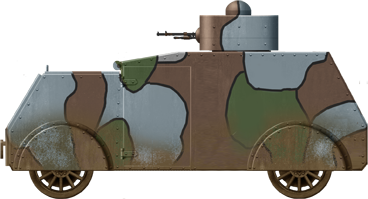
Auto Blindado FS-2
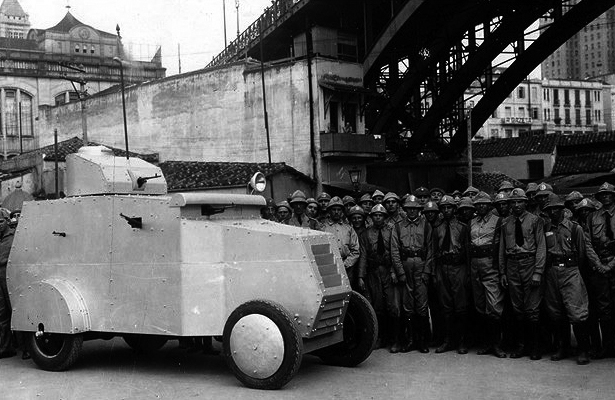
Armored Car FS-5
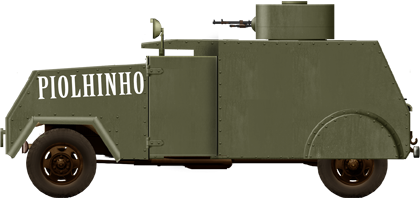
FS-4 Piolinho
The FS-4 was based on a chevrolet 4x2 chassis (unknown type) with pneumatic tires, armored wheel covers, rotating turret with Hotchkiss 7mm LMG. Both Ford and Chevrolet vehicles used the same armor pattern. They were suspended by doubled leaf springs, had only the front axle steerable, manual transmission and a 6V battery. Composite soft steel armour, 2x6 mm, riveted. In all, three different types of armoured cars were identified, FS-1, 2, 3, 4 (nicknamed "piolinho") and 5. FS-6/7 were tractors, FS-8 was a truck-based armored transport (see later).
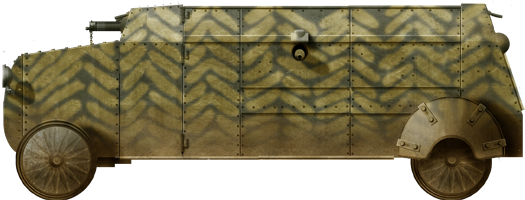
Blindado FS-8, the Paulista's APC
Tactically, these armored vehicles were used as infantry support as well as in reconnaissance or in cover of withdrawals. FS-8 for example, acted in conjunction with TB-6 by September 1932 at Lorena, providing mutual cover during the retreate to Guaratinguetá.
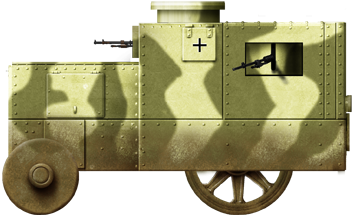
Trator Fordson M1922, FS-6 and 7
Armored tractors had a better grip but were slower, and they were based on Fordson agricultural tractors (Locally made Ford model F1922) used by the Civil Guard of the state of São Paulo, which used the FS-6 and FS-7.
Three other tracked vehicles were produced using the Caterpillar 22 tractor as base. They were so recoignisable as to be called by the Feferalists "Tanks Paulistas". However only two were operational, the third being not ready in time to join the front in this short war. These "tanks" were developed by Captain Reinaldo Saldanha da Gama with the support of the Polytechnic School as the armored cars. The were painted gray and had riveted steel sheet plating and a revolving turret for a light machine gun but also two searchlights for night actions. But moreover they were armed with a flamethrower wioth a range of over 30 meters, and a crew of up to 6 men.
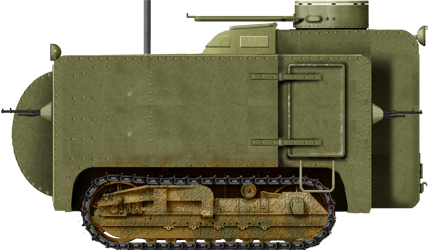
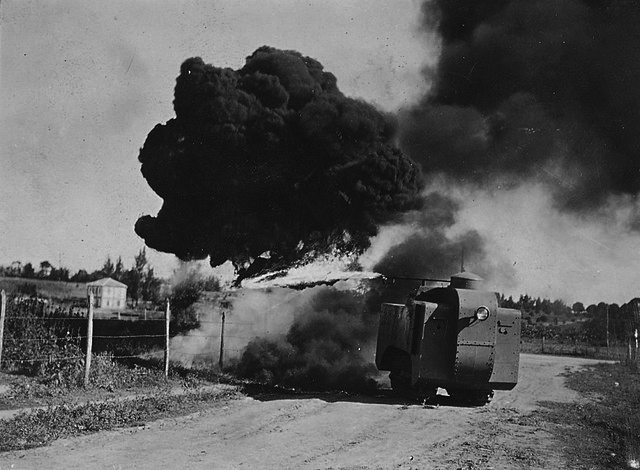
Photo of the same in action
These two "Paulista Tanks" operated mainly on the border with Rio de Janeiro and near the bridge of Queluz, as a deterrence. On the bank of the Paraíba do Sul River, federal troops attempted to advance on the bridge and reach the other end, but they were repeatedly pushed back by one of the two tanks, positioned at the entrance to the bridge or on the river bank as cover for defending troops. Between its machine guns and flamethrower, it repelled all federal assault, day or night.
It should be said that this conversion already had been designed a year before the revolution, for the Public Force of São Paulo, as part of the Assault Car Section. However, it was slow, unstable and not very mobile as a whole. Vibrations had also an effect of the MG fire accuracy. Conditions inside during the summer months were of course also unbearable.
As for the Polytechnic School's armoured speed boats, only four were produced, two only being ready to serve on the São Paulo river network before the end of the war. They operated on the Rio Grande, Paranapanema River and Paraíba do Sul River. They had a crew of up to seven, were armed with a light machine gun and 7mm Mauser rifles. Their appearance and details remained foggy to say the least.
Tanks and armored vehicles of the Federalists
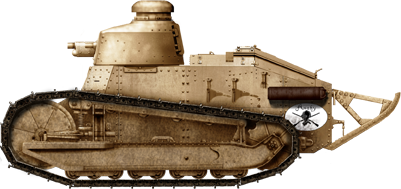
Federalist Forces Renault FT tank used in this 1932 war. The first 12 Brazilian “carros de asalto” acquired in 1921 saw action during the 1924 rebellion and the 1932 revolution.
The Federal Army only armored vehicle used in combat was the French Renault FT tank. However its deployment was limited. Only two were used in the city of Passa Quatro, and they were restricted to reconnaissance missions only,not infantry support. One has been preserved at the Eduardo André Matarazzo Museum, in Bebedouro and the other in the courtyard of the Centro de Instrução de Blindados, Santa Maria. The Renault FT were "stock" equipped and armed like the original French-built models. It seems they were just a part of the 80 or so armoured vehicles sported by the whole Brazilian army at the time.
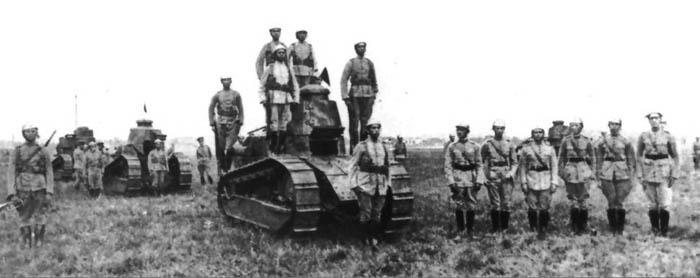
Brazilian FT tanks training in 1921

FTs used in operation in the itaguaré sector, 1932
Unfortunately for the Brazilian army staff, little lessons were learned on the inventivness of the Paulistas with their armored vehicles, as no new associated military doctrines were assimilated, studied or used in the postwar years and up to WW2. The vehicles were dismantled and plans lost. In WW2, alongside the still existing FTs tanks, reduced to training, the country eventually declared war on Germany and was provided tanks and armoured vehicles via lend-lease for its expeditionary corps. M4 Shermans, M3 Stuarts had a very long service life and more so the M8 Greyhound 6x6 recce cars which were rebuilt by Engesa in the 1970s as completely modernized vehicles, the "Cascavel". But this is another story.
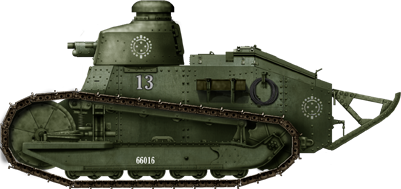
Renault FT in their WW2 livery and national markings, used for training.
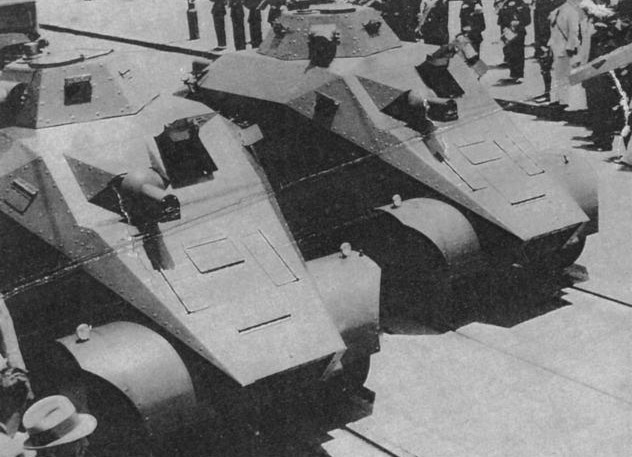
Wilton-Fijenoord armoured cars, acquired in 1935
Read More
Books
Brazilian armored vehicles 1917-39Links
vfco.brazilia.jor.brnetleland.net/hsampa
docplayer.com.br
wiki revolution BR
j1diario.com
almanaquedosconflitos.wordpress.com
/blindados-eb-parte1
pinterest.com/luigistaffa/blindados-da-revolucion
cibld.eb.mil.br
warwheels.net



































































